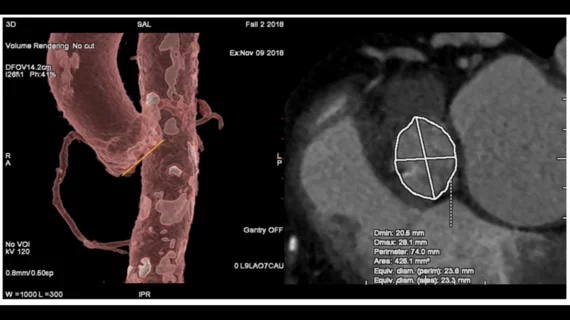TAVR planning with valve-sizing software: GE Healthcare tech easier to use than competition
Planning ahead of transcatheter aortic valve replacement (TAVR) procedures with semi-automated sizing software helps cardiologists match each patient with the best device possible The goal is not undersized or oversized, but something in the middle that would even make Goldilocks proud. Researchers compared the usability of two software tools designed for this very purpose, one from GE Healthcare and another from Pie Medical Imaging, and shared their findings in the Journal of Cardiovascular Imaging.[1]
“Anulus measurement and resulting choice of prosthesis’ size is particularly crucial for a patient’s outcome,” wrote senior author Prof. Christian Butter, a cardiologist with Heart Center Brandenburg and Brandenburg Medical School Theodor Fontane in Germany, and colleagues. “While oversizing might result in life-threatening annular rupture, undersizing can lead to post-procedural paravalvular leakage.”
Butter et al. put two software offerings to the test, GE Healthcare’s Valve Assist 2 and Pie Medical Imaging’s 3mensio Structural Heart. A team of 22 inexperienced users—described as “beginners” for the sake of this study—was taught how to use both programs and then asked to evaluate 129 measurements in three patient cases. While 11 participants used the GE Healthcare software, the other 11 used the Pie Medical Imaging software. The answers from these beginner groups were them compared to answers provided by a team of experienced users—“experts”—from the same cardiology department.
Each beginner completed System Usability Scale (SUS) and ISONORM questionnaires designed to provide a quick snapshot of how easy it was to use the software. While SUS scores represent a “valid and reliable instrument,” the authors noted that ISONOFORM scores are an even better option for identifying issues with how humans interact with systems or products. Overall, Valve Assist 2 was associated with a higher median SUS score (78.25 vs. 65) and higher median ISONORM score (1.05 vs. 0.05).
Valve Assist 2 required users to ask fewer question, the authors added, and it resulted in faster measurements.
The beginners used these software offerings for two test days—testing day 1 (T1) and testing day 2 (T2). With Valve Assist 2, the correct heart valves were selected in 72.7% of cases on T1 and 69.7% on T2. With 3mensio Structural Heart, meanwhile, users selected the correct valve in a whopping 93.94% of cases on T1, but that dropped to 40% on T2. This sudden drop for the Pie Medical Imaging software, researchers observed, could be seen as additional evidence it is harder for beginners to use than GE Healthcare’s Valve Assist 2.
The group concluded that GE Healthcare’s Valve Assist 2 was significantly better from a usability point of view than Pie Medical Imaging’s 3mensio Structural Heart. This may only apply to inexperienced users, they noted, but the data suggests “choosing a particular semi-automated TAVR planning software may have an impact on the TAVR planning process.”
“Further studies with a study population of experienced TAVR specialists are needed to assess the impact of usability of semi-automated software programs on sizing and eventually clinical outcomes,” the authors added.
Butter et al. emphasized that they had no financial conflicts of interest to report; they do not have relationships with GE Healthcare or Pie Medical Imaging that may have influenced this analysis. It is worth noting that this study was originally conducted at the end of 2018. The two software offerings being evaluated could look quite different now than they did at the time.
Click here to read the full study.

